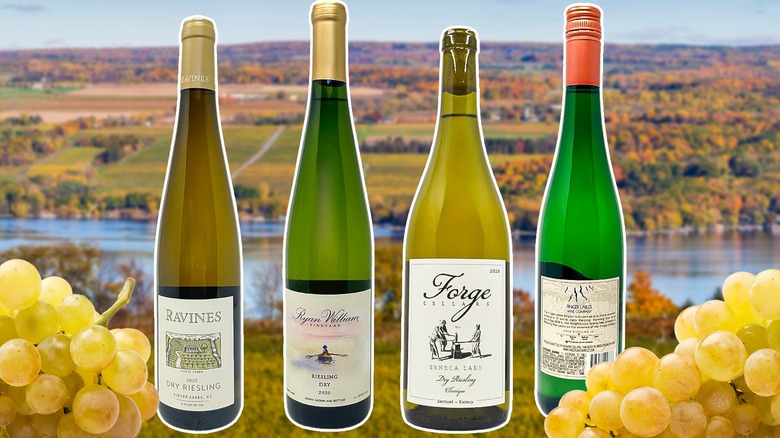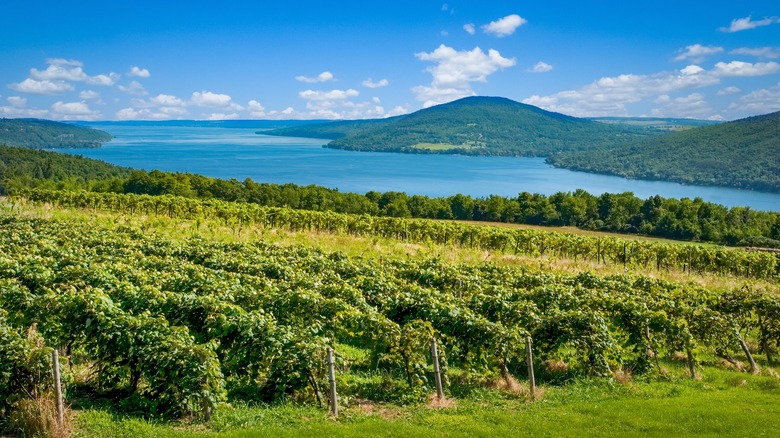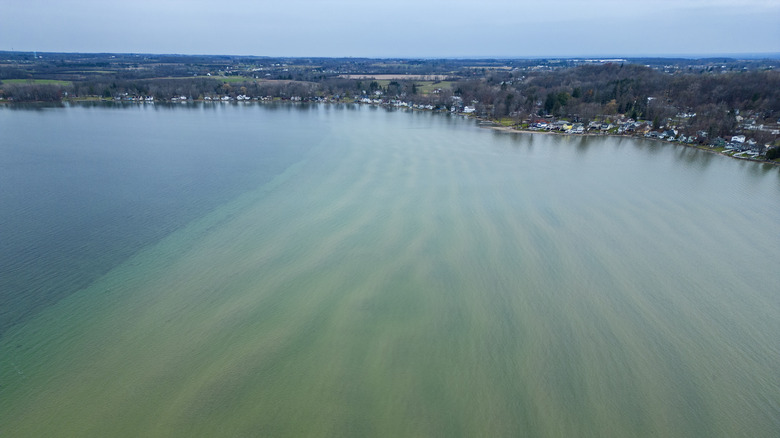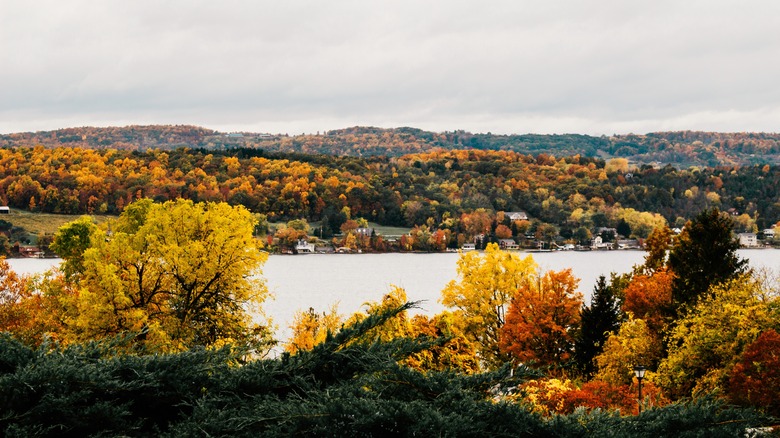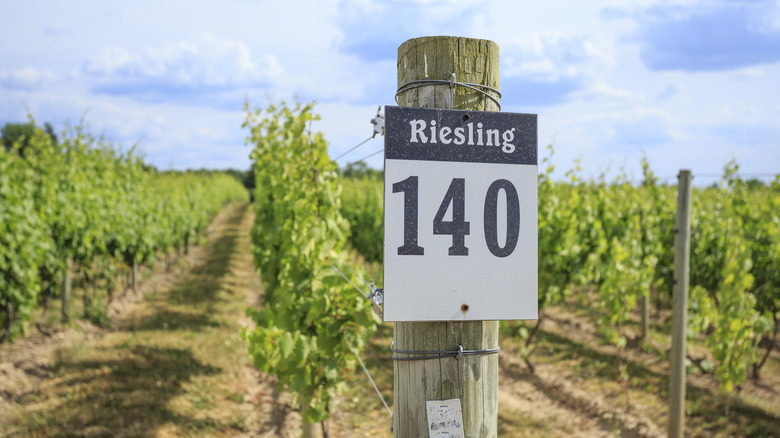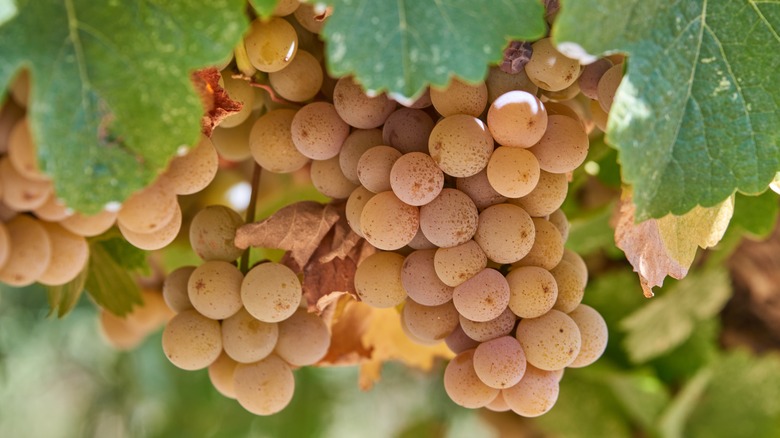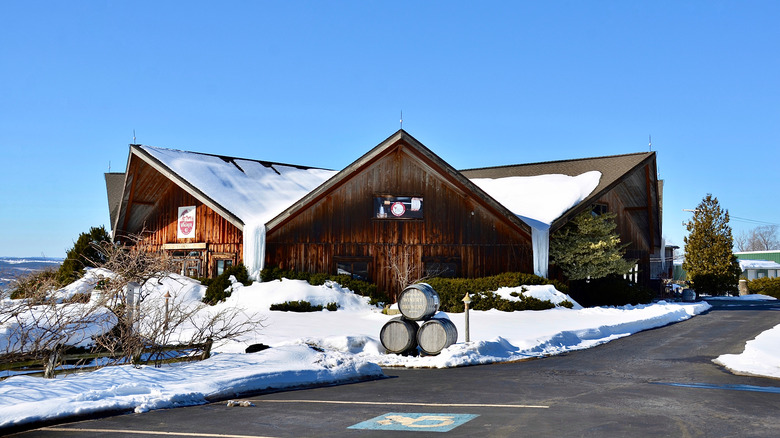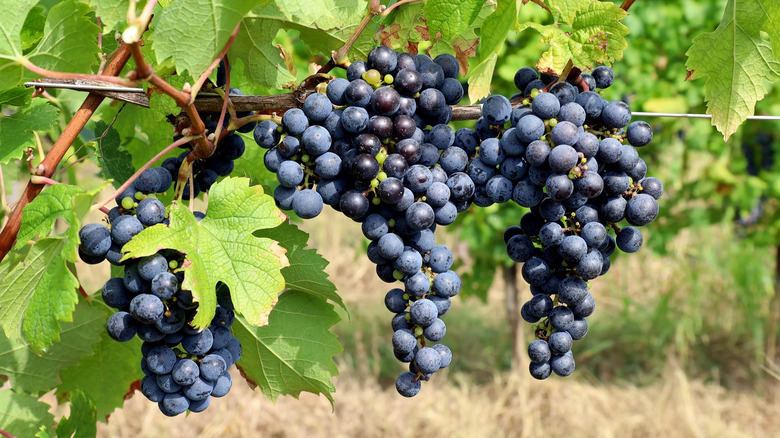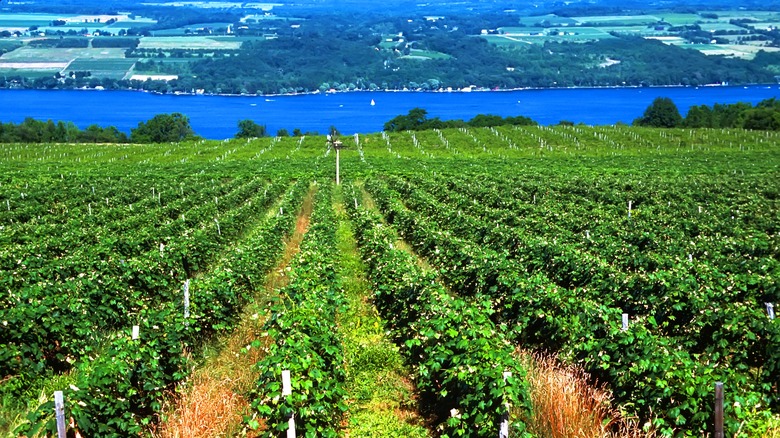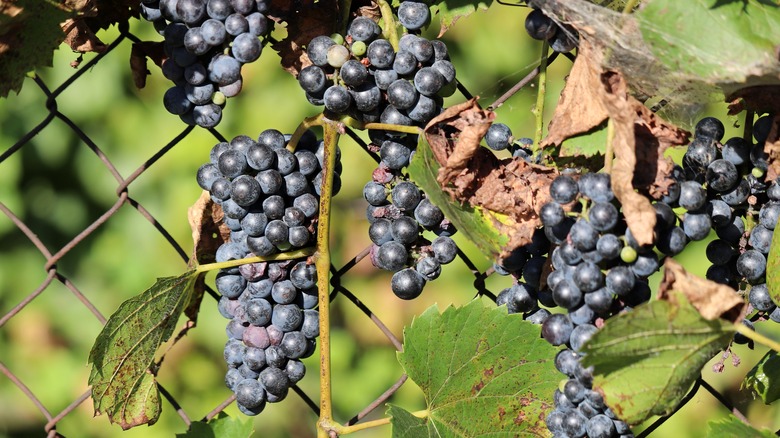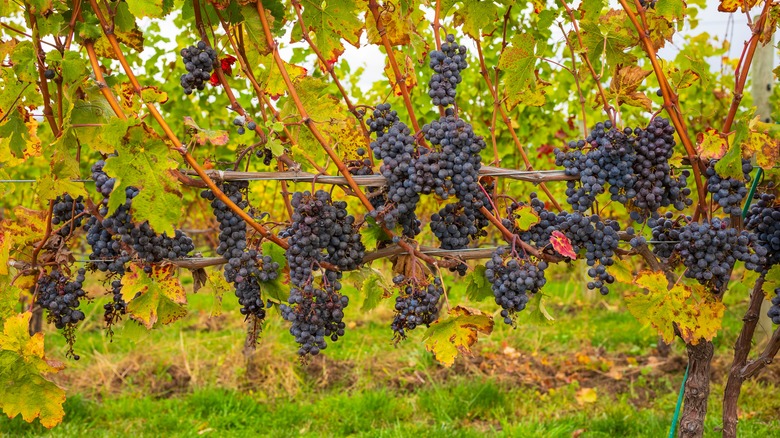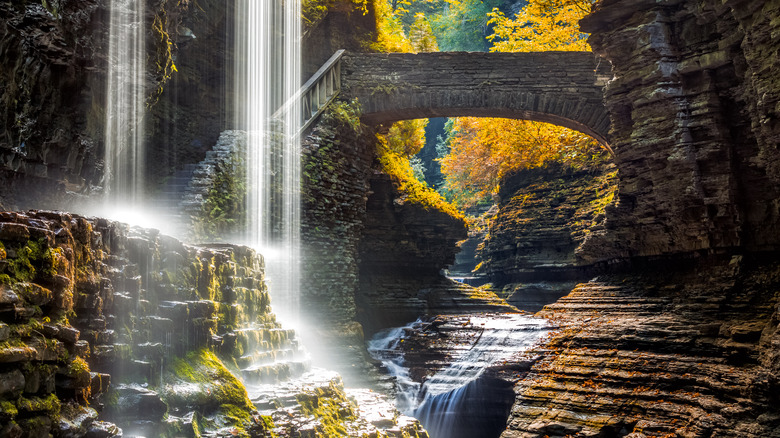The Beginner's Guide To Wine In The Finger Lakes
When you think about American wine, there's a good chance that your mind first goes to California's Napa Valley, or Oregon's Willamette Valley. But there's more to America's wine landscape than what the West Coast has to offer. On the other side of the continent, one wine region is just starting to get the attention it absolutely deserves. The Finger Lakes wine region in New York state is centered around — you guessed it — a collection of lakes, 11 in total. And if you haven't had the opportunity to try wine from the Finger Lakes yet, you need to head to your local wine shop's American section ASAP.
As a certified wine professional, I've traveled to this region multiple times to taste the wines and gain a better understanding of the culture and terroir. To learn more about what makes the Finger Lakes so special, I also reached out to three notable figures in the region's wine scene: Christopher Bates, a master sommelier, chef, and owner of the region's Element Winery; Scott Osborn, the president and co-owner of Fox Run Vineyards; and Bob Madill, a board member of the New York Wine & Grape Foundation.
Whether you're just getting into wine or you're already an educated drinker, there's always more to learn about any region, including the Finger Lakes. Gaining a deeper understanding of this region's world-class wine scene can give you a better idea of the kinds of wines you might want to try once you're ready to dip your (metaphorical) toes into the Finger Lakes.
New York's Finger Lakes region has a cool climate
A wine region's climate can tell you much about what to expect wines from that region to taste like. If you look at a map, you'll notice that the Finger Lakes is quite far north, so it makes sense that this area is a cool climate region. This determines the kinds of grapes that can be grown in the region. Cabernet sauvignon, for example, requires relatively warm temperatures to achieve the rich, full-bodied flavor profile the varietal is known for. But other grapes, like sauvignon blanc, might get too ripe if it were grown in the same spots as cabernet sauvignon. Grapes like these generally require a cooler climate.
If you taste wines from both warm and cool climate regions, you can get a better sense of the varietals and flavor profiles to expect from each type. Of course, there are countless variations and exceptions, but once you taste enough wine, you'll likely notice a trend. And if you just happen to discover that you really like cool-climate wines? Well, then Finger Lakes wines should definitely be on your radar.
The lakes are all important to wine production
In the Finger Lakes, the lakes themselves are integral to wine production in the region. Despite the region's cold winter temperatures, grape production is aided by the lakes, which were formed by glaciers. The lakes function as heat sinks, because the water contained within them retains warmth during the day and releases it after sundown, assisting with moderating the temperatures overnight to foster a steady climate in the surrounding region. This is important because in many cooler-climate regions, grape growers have to contend with frost, which can damage grapes and grapevines. The presence of the Finger Lakes is important in providing a climate in which vines can survive despite cold temperatures.
That's not the only effect the lakes have on grape-growing in the Finger Lakes. Because these lakes were formed from melting glaciers, they've also resulted in a wide array of different soil types being deposited across the region. This allows for a wider variety of grapes to be grown, which is why you'll find so many different varietals and styles of wine coming out of the region.
Wine production is centered around three of the 11 lakes
The Finger Lakes region boasts 11 slender lakes, each with their own appeal for visitors. However, if you're there for the wine, you'll mainly be interested in three of the lakes that are local hubs for wine production. In the center of the region, you'll find Keuka Lake, Seneca Lake, and Cayuga Lake, which are all located next to each other. While the area may look small and easy to traverse, that's not always the case — because the lakes are elongated, it can take some time to travel between different communities on varied shores. If you're visiting the region, make sure to use your GPS to accurately estimate how long it takes to get from one winery to the next.
Two of the region's most longstanding and well-known wineries are located on two of these lakes. Hermann J. Weimer Vineyard, which produces truly outstanding wines, can be found by Seneca Lake, while Dr. Konstantin Frank Winery — known for cultivating Georgian varietals in addition to fine rieslings and gorgeous sparkling wines — features prized vineyards on the west side of Keuka Lake. Both estates are worth a visit if you're in the region, as they can help you gain a deeper understanding of the history of the Finger Lakes, and provide unforgettable tasting experiences.
Riesling is the region's most well-known grape ...
If the Finger Lakes is associated with one grape variety, it has to be riesling. Riesling haters, don't scroll away just yet. While rieslings are known to have high levels of residual sugar — one of the reasons why riesling can be stored for longer than most other white wines — many of the rieslings produced in the Finger Lakes are made in a dry style, so they're a far cry from the sugar bombs you may find in your local grocery store's wine aisle. In fact, riesling's ability to produce concentrated, complex wines makes it a favorite amongst many in-the-know wine lovers.
But how did riesling rise to prominence in the Finger Lakes region? According to Christopher Bates, the area's geographical setup is particularly well-suited to this type of grape. "Riesling has some special qualities that make it suited to our extreme climate, especially in the early days of our development. Its cold hardiness is of supreme importance," Bates says. "Especially as we were first exploring the region and its viability, riesling survived in many sites where more sensitive varieties failed."
But that doesn't necessarily mean there's a glut of riesling in the region. Bob Madill says that riesling production is actually somewhat limited. "One of the most remarkable things about the international stature of Finger Lakes riesling is how little Finger Lakes riesling there actually is: 1,200 to 1,500 acres," Madill explains. "The reputation of Finger Lakes riesling is solidly based on value and not volume."
... But this region is producing an incredibly wide variety of wine
Just because Finger Lakes is known for its riesling doesn't mean that you should overlook the region's wealth of grape varietals. Because of all the soil variation provided by glacial deposits, an incredible number of different wine grapes are produced in this region, with potential for additional types to flourish. "The search for other varieties that grow well and make great wines is an ongoing process," says Scott Osborn. "There are a couple that are rising to the top, such as chardonnay, Traminette, grüner Veltliner, cabernet Franc, and Lemberger."
According to Christopher Bates, this region is ideal for experimenting with new varietals. "The world of possibility explodes in the Finger Lakes. Grapes like merlot, gewürztraminer, and chardonnay have shown their ability to achieve greatness," he says. Even pinot noir, which is famously difficult to grow, is finding a place in the region. "Pinot noir is showing it can achieve heights in certain styles here that are hard-matched anywhere else, but this grape requires meticulous viticulture," Bates adds.
Beyond varietals, winemakers are also exploring different wine styles as well. For example, sparkling wines are a Finger Lakes specialty, according to Bob Madill. "There is a long history behind this style, and some serious producers that craft superb sparkling wines," he says.
Numerous wineries operate in the Finger Lakes region
If you've never encountered wines from the Finger Lakes, then you may assume that it's a tiny region. However, there are almost 150 wineries operating within the Finger Lakes AVA. What is an AVA, you ask? AVA stands for American Viticultural Area, which is a designation for grape-growing regions with distinct features of geography or climate that make them unique and provide special impacts on how grapes are cultivated. Within the Finger Lakes AVA are two smaller, more specific AVAs: the Cayuga Lake AVA established in 1988, and the Seneca Lake AVA established in 2003.
The Finger Lakes AVA encompasses some 11,000 acres of vineyards, and every year, the region produces around 54,600 tons of grapes. As the region becomes more well-known, demand grows for the wines from this corner of New York state. Exports are increasing as more wine lovers realize all that the region has to offer.
The Finger Lakes may not be known for red wine, but cabernet Franc thrives here
When a lot of people think about the Finger Lakes, white wine is the first thing that comes to mind. But in recent years, red wine is becoming more common in the region. Generally speaking, red grapes require more heat to ripen properly than do white grapes, which means that red grapes don't always do well in cool climates, like the Finger Lakes. But as climate change affects the average temperatures in the Finger Lakes, red wine production is becoming more viable.
Arguably the most celebrated red wine coming out of the region is cabernet Franc. "Cabernet Franc, I would argue, is currently being made in the Finger Lakes as well as anywhere else in the world," says Christopher Bates. "Cabernet Franc is well-suited to many of our climate challenges."
Luckily for the region, cabernet Franc — which tends to be a bit lighter, fresher, and often more vegetal than, say, cabernet sauvignon — is in line with current wine trends. "Taste and style in red wines writ large is moving towards the Finger Lakes," says Bob Madill. "Wines that are enjoyable to drink with or without food. Fresh, stimulating, balanced, with a certain genuine and attractive simplicity."
Vines in the Finger Lakes region were planted well before Prohibition
The Finger Lakes is far from new to wine production. In fact, the Finger Lakes is a pre-Prohibition wine region. Lasting from 1920 to 1933, the Prohibition era was a time in the U.S. when the manufacture and sale of alcohol was illegal. But by the time Prohibition began, the Finger Lakes had already been producing wine for quite some time.
It's recorded that in 1829 the very first vineyard was planted in the Finger Lakes community of Hammondsport by Reverend William Bostwick. In 1860, the region's first bonded winery was established. Additional wineries were founded in the region by the 1880s, long before Prohibition came into effect and alcohol production was curtailed. The history of Finger Lakes wine, then, is old.
Hybrid and native grapes play important roles in the region's agriculture
The majority of wines on the market are made with a species of grape called Vitis vinifera. This accounts for most of the white-wine varieties you've likely tried before, and Vitis vinifera is also the grape species almost all red wines come from. But the Americas boast different native grapes that have largely been deemed unfit for wine production.
However, some regions — including the Finger Lakes — have embraced both native varieties and hybrids, which are native varietals crossed with Vitis vinifera. Many of these varietals are considered hardier and require fewer inputs (like pesticides), which can make them easier and sometimes more environmentally sustainable to grow.
There are some outstanding examples of wines made with native and hybrid wine grapes in the Finger Lakes, according to Scott Osborn. "There are some fantastic hybrids, such as traminette, that make world-class wines, and we should not be afraid to experiment with them," he says. Bob Madill echoes this sentiment. "It has been my pleasure to open a 30-plus-year-old Niagara Baco and watch a revelation being ingested by a very startled, experienced taster," he says, adding that "recent developments with Marquette are really promising."
Interested in trying some of these Finger Lakes wines made with hybrids? The region's Living Roots, Osmote, and Montezuma wineries are all making some impressive wines from native and/or hybrid grapes.
Sustainability plays a huge role in Finger Lakes viticulture
In many ways, "sustainability" is a buzzword, and it's often used as a selling point without a lot of explanation. Wine drinkers should be curious about what claims of sustainability really mean, and shouldn't necessarily take them at face value.
But, like almost every wine region, sustainability and its many definitions are of growing importance in the Finger Lakes, especially as climate change grips the wine industry. Scott Osborn emphasizes that the region's winemakers are taking this issue seriously. "In 2022, the New York Wine and Grape Foundation started developing a program and workbook which would certify wineries and vineyards as sustainable," he says, noting that about 60 Finger Lakes wineries are certified as sustainable under this program. "There is a strong movement towards sustainable agriculture, not only so we can produce better grapes, but so we can protect these beautiful lakes."
Sustainability is about more than just preserving the environment. Wineries of the Finger Lakes, like in many regions, are putting plans in place to move in the right direction.
The Finger Lakes region is a great place for vacations
It's no secret that taking a trip to Napa or Sonoma is going to be a drain on your bank account. These well-known regions are famously pricey, and it can be difficult for many wine lovers to afford a vacation to these wine hotspots. However, the Finger Lakes offers cost-effective options for those who want to visit wine country.
Of course, winery tasting rooms are a great place to start — you can get a taste of the region by trying a variety of different producers' wines. If you only have a short amount of time in the Finger Lakes, you should head to Once, a regional tasting room that offers visitors a selection of wines from a number of the region's wineries, along with bites made with local ingredients.
But the Finger Lakes has more to offer than just wine. The lakes offer a variety of recreational activities, and gorgeous hiking trails await outdoor-inclined visitors. Check out the area's restaurants, ranging from Elderberry Pond — a farm-based fine-dining eatery serving organic foodstuffs produced on-site — to the F.L.X. Wienery, where you can wash down a top-quality hot dog with truly incredible wines. And if you want to wake up to a stunning view, consider staying at a lakefront hotel.
The Finger Lakes is a deeply collaborative region
Winemaking practices can vary drastically from region to region — and even from vineyard to vineyard — so grape growers and winemakers will often lean on their wine-producing neighbors for support. That's certainly true in the Finger Lakes, as confirmed by Bob Madill. "The Finger Lakes is genuinely collaborative. I have had extensive personal experience during my wine-growing days at Sheldrake Point, being on the grateful receiving end of help from neighboring wineries, Lucas Vineyards and Hosmer Winery," he recalls, adding that the Finger Lakes has "a farming culture of generosity arising from adversity."
According to Christopher Bates, the fact that the Finger Lakes is still a developing wine region is a key reason why collaboration is so important. "Like most developing regions, we realize that a rising tide raises all boats, and that together we are stronger and we will all benefit from our neighbors' successes," he says.
